Keywords:
Like people, cats need vegetables in their diet to aid in digestion and to provide balanced nutrition. All you do to serve your cat is place Kitty’s Garden near their food dish or in some other place they'll find it. You can find Catnip Plants information and where to buy it now and cheap price here.
Tuesday, April 30, 2013
Da Kine finds the catnip
Keywords:
Cats pruning catnip plant II
Part II including play cat fight, butt shots and Sly hogging the catnip plant..
Tags:
Monday, April 29, 2013
Catmint - observe The medical Qualities Of The Herb
The article deals with the healing qualities of catmint. It describes uncomplicated guidelines on how to dry the herb and use it when dealing with varied condition problems, such as, flatulence, bronchitis, insomnia, hysterics, melancholia, menstrual disorders, nervousness, inflammation of airways, lack of appetite and other digestive disorders.
 [b]Catmint[/b]
[b]Catmint[/b]
Catmint is a perennial with a stem growing to a height of 100 centimeters. The branched stem is covered with tiny white hairs. Blossoms are arranged in dense whorls. The whitish blossoms are covered with tiny purple or violet spots. The herb blooms in July and August. Fruit consists of 4 smooth and dark brown nutlets.

Catmint is a herb native to Southern Europe and Mediterranean area. The herb is cultivated as healing herb, nectar plant and culinary herb in many countries. You should collect catmint tops. Plainly cut up to 30 centimeters long flowering tops of the plant. You should dry the herbs at a room temperature. When drying the herbs, avoid exposing them to direct sunlight. You can dry them in a drying camera, as well, as long as a temperature does not exceed 40 degrees Celsius.
Catmint tops are said to include considerable oil (up to 3 percent), iridoids, saponins, coumarins, bitter substances, tannins and other biologically active substances. considerable oil contains citral that is responsible for the lemon aroma the herb has. Owing to this exact aroma, catmint is sometimes wrongly referred to as melissa that is completely different herb.
The active substances the herb contains have varied follow on your body. The herb is used to stimulate appetite, improve digestion and heal wound. In addition, it has antimicrobial and expectorant action.
The herb is proven to fight flatulence (gas accumulation in stomach and intestine) and facilitate expectoration. Remedies made of it can be used in case of inflammation of airways and bronchitis. Moreover, catmint is said to preclude insomnia, nervousness, hysterics, melancholia and menstrual disorders. In order to make an infusion, you should infuse 2 tablespoons of granulated tops with a glass of boiling water. Leave the infusion to brew for 1-2 hours and decant it. Drink one fourth of a glass of the infusion 3 times a day 20-30 minutes before meal.
You can add catmint tops to your daily tea to improve the aroma of the tea. The aroma of the herb is proven to have stimulant follow on cats similar to that of valerian.
Catmint - observe The medical Qualities Of The HerbSunday, April 28, 2013
The Benefits of Catnip
It's a well known fact that cats love catnip, right? Actually, not all cats do. Some of the investigate on this feline popular recreational "drug" shows that not all cats are sensitive to it. Also, it appears that kittens can't detect it until they are at least three months old, and senior cats have whether lost or never had an interest in it.
 [b]Catnip[/b]
[b]Catnip[/b]
Catnip is not a drug, of course, but is an herb, a plant in the mint family. Also known as catmint, it can be enjoyed by humans as a tea, though we aren't affected the same way. Some people feel it has a relaxing quality, but then, that is typical of most herbal mint teas.
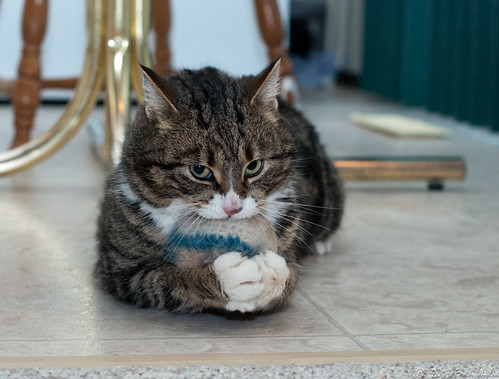
Clearly, though, it doesn't relax most cats! For those of us who have dissolved into quivering lumps of laughter watching our cats go berserk with a dose of it, we have to wonder just what is going on there. Catnip does have a pleasing, mild fragrance that relaxes us but gives most cats a real buzz.
Apparently, this aroma is picked up by separate olfactory receptors than lowly scents and acts similarly to pheromones, so some feel it elicits a "psycho-sexual" response. The way many cats react seems to verify that idea, as they may roll colse to on the floor, rub up against everything, groan, growl, purr, or "trill."
Here is what we know about it so far:
1. It won't hurt the cat. It's not a drug, but an herb, so it is quite safe. So don't worry... You can't give them too much.
2. However, if you do offer it too often, cats will become desensitized. This means they won't get crazy anymore and will ignore it. In fact, it loses its request for retrial in about 10-15 minutes, but most cats can find it inspiring again in a concentrate of hours. Still, if offered on a daily basis, the desensitization could become permanent.
3. The active ingredient is the plant's critical oil, called nepetalactone.
4. Kittens and older cats seem not to notice it, and only about two thirds of adult cats enjoy it.
5. Catnip sensitivity appears to be genetic. Most cats in Australia, for example, are not concerned in it, since they are mostly from a fulfilled, genetic ancestral pool, and the "detector gene" doesn't show up very often. Don't worry if your cat isn't interested... She probably just doesn't have that gene.
6. While sniffing is the most coarse way cats "consume" it, they also may eat or lick it. Since it's not toxic, don't worry about that, either. If they eat a lot, they may vomit, as they might after eating grass.
Other than amusing ourselves, does catnip have any benefits to the cat? Since there seem to be no detrimental side effects, then it can only mean one thing: Yes!
Here are some good reasons to offer catnip to your kitty:
Helps to comfort boredom.
Motivates an indoor cat to get some exercise.
Helps a shy or fearful cat to feel less inhibited, especially in a new home.
Gives a cat under stress a chance to run off some vigor so it doesn't become neurotic.
Another plant that has similar effects on cats is valerian, which is a relaxant for humans, as the mints are, but is excitatory for cats.
The Benefits of CatnipWhat Is The Best Catnip and How Should It Be Given To Cats
Catnip or catmint are common names for a perennial herb of the mint family, Lamiaceae/Labiatae. Catnip was originally cultivated in Nepete, Italy, where it received its scientific name, Nepeta cataria.
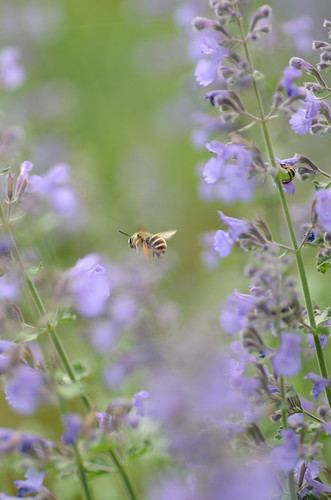 [b]Catmint[/b]
[b]Catmint[/b]
Catnip grows up to about three feet high and wide. The flowers are tubular shaped, small, white and speckled with tiny purple spots. Catnip is positively very easy to grow and will thrive in almost any soil. Water requirements are moderate and it does best in full-sun.
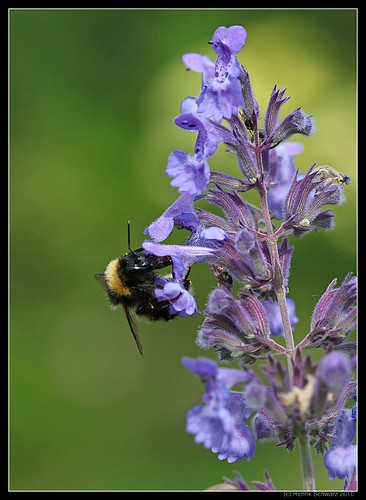
Not all cats like catnip, it appears to be an inherited gene and whether your cat likes it or couldn't care less about it. Very young kittens and older cats do not tend to be effected by catnip.
Given to the right cat, catnip can cause an amazing reaction! The cat may roll in it, chew it, paw at it and some even eat it. The cat's olfactory receptors, being sensitive to the nepetalactone in catnip, trigger this reaction, so if you are lucky your cat will love catnip.
The "high" or "trip" will last for only a few minutes, then the cat will lose interest and walk away. Remove the catnip for a consolidate of hours and then give them a small more and they will have the exact same response.
I recommend using catnip as a treat and not giving them a toy with catnip in it. The toys normally have some dried old stuff in them and the cat swiftly loses interest, because the toy is all the time there. It would be good to give them toys without catnip and just keep a bag of catnip in the refrigerator, to keep it fresh, and give them a pinch of dried catnip on special occasions.
Cats are natural-born hunters and if you have ever watched a cat with a live mouse, you know that they love to play with their food! This is why I recommend not giving them a toy filled with catnip and just leaving it in the room. The cat will play with a mouse it as long as it is alive and then whether eat, it if he is hungry, or simply leave it and walk away. Just like with the live mouse, the catnip-filled mouse may be moving at first, but after a while the cat loses interest. Most cat toys have very small catnip in them and it is normally old and has lost most of its potency. Think about it, most cat toys come from China!
Cats want excitement, something different, giving them a pinch of good catnip is more of a treat!
Catnip is not harmful to your cat and they won't overdose on it. It is just a fun way of giving your cat a treat. If you have more than one cat, give each cat its own pinch of catnip to avoid competition.
Catnip is said to be a very distant relative to marijuana, but humans can not get "high" on catnip. However, catnip does make a great tea, which has a sedative consequent and is soothing to the stomach. Pregnant women should not take catnip.
Catnip is an easy herb to grow and the higher altitude it is grown in, the more potent the nepetalactone or needful oil content, and the more work on it will have on the cat.
What Is The Best Catnip and How Should It Be Given To CatsFriday, April 26, 2013
Catnip Oil
Catnip oil comes from the leaves of the catnip plant, by extracting the essential oil that is produced in the upper layer of the plant. This is a treat for cats, and you and your feline friend can have hours of (often) silly fun. It can also be used to soothe and relax your pet. You will also find that catnip is an excellent training tool - you can use it to get your cat used to its bed or to get it near the scratching post - this is quite useful if you don't want anything to happen to that leather couch you have!
What's more, you can apply some catnip on a toy to encourage your pet to have some exercise. Your cat with have hours of fun with a favorite toy - tossing it, biting and licking it, as well as chasing it about. This may prove handy for those who are not that mobile but still want to give their cats some exercise.
Catnip Plants
Catnip oil is essentially harmless to cats, but people will attest that it makes some cats crazy and silly! Some will even say that the oil is some sort of aphrodisiac. Cats who get a whiff of catnip may sometimes run around the room, pretending to play with an unseen friend. They may also endlessly chew, lick and rub their cheeks on the very place that catnip has been applied. They can also lie on their backs with paws extended. Or, they may appear lethargic, dreamy and sleepy and may lie motionless for quite a while.
Whatever your cat's reaction is with catnip oil, one thing's for sure - it will not just entertain and keep your cat pleasantly occupied - it will entertain you as well. Yes, you will also enjoy your cat's silly antics! A word of warning, though. If you find that your cat exhibits aggressive behavior after you apply catnip oil to their toys, look for alternatives such as valerian-sprinkled or honeysuckled-infused toys.
Catnip OilHow to Grow Your Own Catnip
Almost all types of cat, from lions to your household kitty, love catnip. They are not fussy about the form in which it comes; they will take it fresh, dried or inside felt toys. Interestingly, however, not all cats are attracted to catnip. In fact, it is understanding that almost 1/3 of cats are not responsive to it at all. Nevertheless, this means that the vast majority of cats love it and the good news is that it is relatively uncomplicated to grow your own.
 [b]Catmint[/b]
[b]Catmint[/b]
What is Catnip?
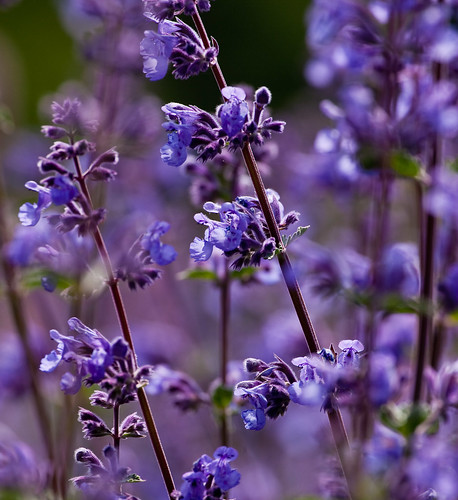
Catnip, or catmint as it's sometimes called, is a herb and belongs to the mint family. So, why do cats love it? Well, catnip contains an active chemical called Nepatalactone, which is very similar to a chemical that is found in female cat urine and it is this which drives cats crazy. No, it wouldn't do whatever for me either, but can 2/3 of cats possibly be wrong?
Using Dried Catnip in Toys
Although they love it fresh, it is impossible to have a supply of fresh catnip all year round. So, a great way to sustain it is to dry it and place it inside toys. Like growing it, drying catnip is very simple. Just spread out the flowers and leaves that you have harvested in a well-ventilated area. After the catnip has dried out, it is advisable to place it into airtight containers, as this will help to keep it fresh throughout the autumn and winter months.
Making uncomplicated catnip toys could not be easier. Just sew a small piece of fabric to form a pillow or pouch, which you can then fill with your freshly dried catnip. The scent will not last long, so may need refilling from time to time.
Is it potential to Give Too Much?
Yes, according to some experts it is potential to give your cat too much catnip. It is understanding that regular and repeated exposure means that a cat becomes immune to the effects. Therefore, it is advisable to only offer your cat catnip once a week. It is also wise to keep a close eye on your catnip plants; if your cat is killing the plant, it may be primary to produce some sort of security to forestall any added damage.
If you would like to be able to give your cat a itsybitsy treat now and then, growing your own catnip couldn't be easier.
How to Grow Your Own Catnip:
Catnip seeds can be purchased from most orchad stores, alternatively you may prefer to buy from an online store. Catnip is easy to cultivate and thrives in sun or itsybitsy shade. It is a perennial plant, which means it will return each year. Catnip does not need much care, as it can thrive well on its own. However, this means that it can take over a garden, so it primary to leave room for the plant to grow and spread. A small tip for catnip increase is that removing the shoots of the plant prompts thicker and bushier growth.
If you plant catnip in the spring, it should flower by early summer. While the plant is in bloom, cat owners may wish to harvest the flower, top leaves and stems, these can then be located into a toy or stuffed into a small pillow case. according to some gardeners, three good harvests of catnip can be produced in one year. Because cats are particularly partial to fresh catnip, you may just wish to leave your cat with access to the plants. However, a cat is likely to chew the leaves, rub against and roll in the catnip, which can kill the plant.
How to Grow Your Own CatnipThursday, April 25, 2013
Best Catnip
Many cat lovers buy their cats toys, treats, fancy foods, etc. But the top stock on the cat lovers buyer list is...catnip. There are many dissimilar types of catnip; organic catnip, costly catnip, cheap catnip, kitten catnip, and many more. But which is the best catnip?
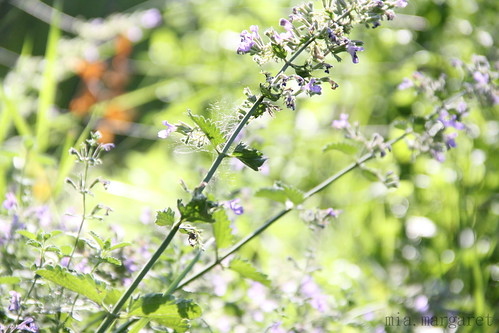 [b]Catmint[/b]
[b]Catmint[/b]
Catnip originated overseas in the Mediterranean and in Europe. It was first used as a part of early pharmaceutical needs of many humans and was brought to North America by early settlers. Catnip back then was called Catmint. "Mint" was added to the word because of the mint like aroma that this herb produced. Later throughout the centuries habitancy began to consideration that feral cats were oddly attracted to this plant. The cat was attracted to the scent. Once this wild cat smelled this herb his mind became fixated on the feeling that overcame him.

As more and more cats became domesticated, cat lovers enjoyed finding their new companions at a happy state and gave their cat catnip. As the need for catnip grew, habitancy began to sell this and make a profit.
Only in the last few decades did the concern for the health of the cats grew. This is when many dissimilar kinds of catnips originated. For many years habitancy thought that catnip was a kind of drug for a cat and did not want to risk the protection of their cat for pleasure. When profits began to die down, manufacturers began to look into more herbal ways to make catnip. We, now a days, may call this herbal catnip, 'green catnip'. When the risk of our feline companion's health was resolved, most Americans bought this kind. Throughout time many habitancy sought this catnip to be the best catnip.
So when habitancy want to hunt for the best catnip for our domesticated feline companions, the majority of us succeed in buying a more costly herbal cat treats.
Little do we know, either the catnip be herbal or more chemically produced, it does not matter for the cats health. Catnip is not a bad treat for any age cat to have.
The most important thing for us, cat lovers, to know is that not all cats react the same way to this delicacy. Most kittens do not react to the aroma of catnip. Their minds do not react as well as an older cat would. When cats hit their prime, this is mostly after they are 1 years old in human years, they react more to catnip and enjoy this thrilling scent. The older the cat gets you may consideration the less active he or she gets. Their inactiveness will also decrease their reactions to catnip.
So when finding to buy catnip for your cat, any catnip will do. Just make sure your cat is in his or her prime and enjoy the happiness you just provided to your feline companion.
If you want more information visit here for the best catnip.
Best CatnipWednesday, April 24, 2013
Nepeta Faassenii 'Kit Kat'
Finally a Truly contract Nepeta!
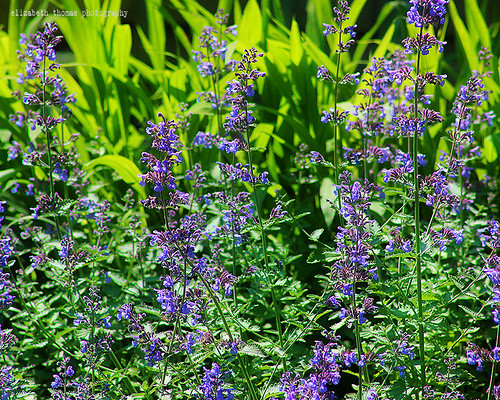 [b]Catmint[/b]
[b]Catmint[/b]
As a group, the assorted forms of Nepeta faassenii, generally called Catmint, have a lot going for them. They are long-lived, easy-to-grow, drought tolerant and long-blooming. The deer don't like them and the butterflies love them. In fact in some gardens nepeta is the perennial that is most enchanting to butterflies, rivaling even the shrub butterfly bush. Nepetas are widely used in English perennial borders massed as a foreground plant, and as an edger. To date nepetas have had one major drawback, they tend to sprawl in a floppy manner. A few years ago a range called 'Walker's Low' was introduced from England and was fast heralded as the long sought contract nepeta. When 'Walker's Low' proved to be just as tall-growing and floppy as the other nepetas, it turned out that 'Walker's Low' is the name of a place in England and has nothing to do with the height of the plant. Now with the 2006 introduction of 'Kit Kat', there is finally a contract neater Nepeta faassenii.
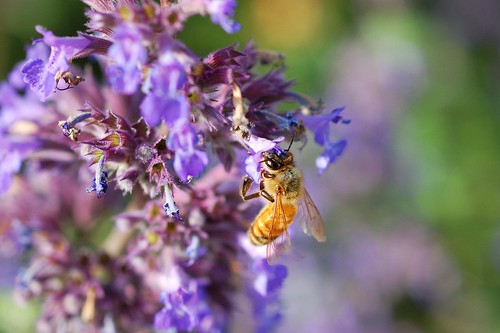
Add Continual Summer Color to Your Garden
'Kit Kat' will add color to your organery throughout the summer. The leaves are grey-green and are toped with spikes of small clusters of lavender blue flowers from June until August. At 15-18 inches high, it is not only smaller in height, but smaller in all of its parts. 'Kit Kat' has smaller leaves and flowers, but the flowers are much more numerous than other nepetas. It will thrive in sunny, dry areas, but also tolerates light shade, if the drainage is good. 'Kit Kat' is ideal as an edger, especially for an herb garden, as well as for summer color massed in front of shrubbery or to dress down foundation plantings.
Planting and Care
Nepeta Faassenii 'Kit Kat'Tuesday, April 23, 2013
Keeping Your Houseplants Safe With Cat Grass and Catnip
Do your cats nibble incessantly on your houseplants? If you're tired of little bite marks in your ferns and waking up to your bamboo on the floor, get them something of their own!
Cat grass (Dactylis glomerata) gives cats something to munch on, and supplements their diet with a variety of essential nutrients. Cats can eat a few blades of grass every day, so give them ample amounts of it to keep them coming back.
Catnip Plants
It's best to plant a bunch of it in a short, wide pot and place it within easy reach of the cats. The wide pot prevents the cats from tipping it over, which would create even more mess.
Some cats end up expelling the cat grass through vomiting. While this is good for the cats (by reducing hairball problems) it can cause all kinds of headaches around the house. You can buy small quantities of cat grass to test your cat's reaction to it before buying a plant that will make your cat puke all over the place.
You can supplement the cat grass with catnip for an extra treat for the cats that will hold their attention, leaving your house plants alone. Make extra sure that the pot is sturdy and hard to knock over (it may help to weight the base) as cats tend to go batty around catnip. Catnip doesn't make cats throw up, so if your cat ends up puking after eating cat grass, catnip is a great way to go.
Keep the cat plants in a container away from the food, so they don't see the plants as regular food.
Keeping Your Houseplants Safe With Cat Grass and CatnipMinecraft 3 player Survival ft. Vorigan , Catnip and Nighthammers Ep 2.
3 Player Survival series with me, Catnip and Nighthammers. Loads of fun stuff happening, this is Day 2. This is our first home build!! Enjoy and plz like /su...
Tags:
Sunday, April 21, 2013
Types of Mint to Grow
Mint is a ubiquitous herb that is well known for its cooling properties.
 [b]Catmint[/b]
[b]Catmint[/b]
Many people associate peppermint and spearmint for freshening the breath.

Yet there are many other types of mint that are beneficial and can unquestionably be grown in the garden.
First, it's foremost to know that mint belongs to the family with the Latin name of Labiatae. The herbs in this family are numerous as there are hundreds of varieties of mint.
These consist of varieties such as chocolate mint, the well known spearmint, water mint, apple mint, pineapple mint, ginger mint, candy mint, black peppermint, Eau de cologne mint, red spearmint, Eau de Cologne mint, catmint/catnip and the lovely groundcover Corsican mint.
Other members of the mint family that are lesser known consist of lemon balm (also known as balm), bergamot, horehound, marjoram and pennyroyal.
While some herbs are grown or remedial or culinary uses, others are naturally grown for attractive uses. This includes Corsican mint and pennyroyal.
Pennyroyal is used as an insect repellant and should not be ingested as it is poisonous. The herb has been used in flea collars for dogs and cats and can be dried for that purpose.
Corsican mint is a dense low growing groundcover that forms a rug of tiny, piquant green leaves which have the alluring scent of creme de menthe.
This herb is great for walkways, rock gardens, outside ugly spots between paving stones and spilling over walls or out of urns. A dense patch of Corsican mint can take the place of grass and form a 'lawn' that never needs to be cut. It does, however, need part shade to grow best as full sun will dry it out and burn the leaves.
Despite it's piquant scent, Corsican mint does not have any culinary use.
Most of the other mints are upright plants and do not make good groundcovers. However, like Corsican mint, most mints prefer partial shade and moist, well-drained soil rich in nutrients.
However, this does not always apply to the lesser known members of the mint family such as lemon balm, bergamot, horehound and pennyroyal.
Lemon balm, bergamot and horehound are herbs that prefer full sun. This is also true for catmint and catnip. However, these herbs don't mind some shade for part of the day. Pennyroyal does well in the shade or in a sun/part shade combination.
So when growing a particular herb in the mint family, it is best to check the growing conditions for that plant. Some of the herbs, like horehound, do best in a dryish, more alkaline soil.
While many members of the mint family are known more for the use of their leaves, bergamot is one that has remarkable flowers and is grown more for attractive use than culinary.
The culinary varieties of mint can be harvested to make tea and it is always fun to make herbal tea blends, such as a lemon balm/peppermint combination. Yet the mint family has so many more attributes it is worthwhile to scrutinize the gardening secrets as well as harvesting, culinary and remedial uses.
Types of Mint to GrowCatnip part 2 :p
Cats on catnip again lol.
Tags:
Saturday, April 20, 2013
Cat Loves The Catnip Plant
Mr Punky-Buttocks-Battenburg -Armstrong is enjoying his catnip though Mr Micky Armstrong - Burton is eager to join in !
Keywords:
Friday, April 19, 2013
Charlie loves Catnip
I was harvesting my catnip plants this Saturday. Tossed a stray piece to Charlie as he sat on the mantle watching. This is the result.
Tags:
Catnip cat
Catnip cat.
Tags:
Thursday, April 18, 2013
Summer Enjoying Fresh Catnip
I have catnip plants growing in my backyard for my cats. My plan is to dry out the leaves for making cat toys. This is summer's reaction to fresh catnip. A c...
Tags:
Wednesday, April 17, 2013
Catnip and Your Cat
If you are the proud owner of a cat or kitten, you may have explored the joys of giving your feline friend a catnip toy to play with. If so, you may be interested in knowing what it is about this plant that appears to make your cat go wild. The reality is that, although we do know some things about this interesting plant and the effects it has on cats, scientists still aren't completely certain why it causes the reaction that it does.
Your Cat's Response to Catnip
Catnip Plants
Despite the popular conception, not all cats are affected by catnip. In fact, most experts agree that only about 30 to 70% of the feline population appears to be affected by this plant. For those that are affected by catnip, however, the reaction can be quite extraordinary.
Not all cats react the same way when exposed to catnip, but some characteristics that are typically associated with catnip exposure include:
• Chewing, sniffing and batting at the catnip toy
• Profuse salivation
• Head shaking
• Rolling around or rubbing themselves on the floor
• Falling and stumbling
• Seemingly kicking with their hind feet
• Chasing around the room
• Elevated excitement level
In short, cats behave as if they are feeling an uncontrollable amount of joy or ecstasy when they are exposed to the catnip toy or source.
Understanding the Catnip Reaction
Although scientists are not certain why catnip causes the reaction that it does, they have isolated the part of the plant that causes the reaction. What we know as "catnip" is actually part of a mint plant by the name of Nepeta Cataria. The plant, which is characterized by small, pale flowers on spikes, contains a substance called nepetalactone. It is this substance that causes the reaction in cats.
In an effort to better understand why catnip causes the reaction that it does, researchers consider the response that it elicits. For example,
• Playful behaviors indicate the cat is having fun and that catnip alters the feline's mood
• Chewing and salivating indicates an appetite response
• Rubbing and rolling may be a sexual response, as it mimics the behavior seen when a cat is in heat
• Leg kicking and chasing may be a predatory behavioral response
Based on these observations, it appears that catnip may help a cat lose its inhibitions by stimulating the brain in the area around the hypothalamus, which is responsible for controlling predatory, appetitive and sexual behaviors. Recent research has also concluded that the nepetalactone in catnip has an opium-like shape, which means it may stimulate the opioid receptors in a way that is similar to how morphine affects the human brain.
Although this research may lead you to worry about catnip causing harm to your pet, research has shown that it is not harmful in any way. In fact, some research has indicated that catnip exposure may actually be beneficial in some cases. For example, cats that do not get along have actually been able to improve their relationship after one or both cats is exposed. It has also been show that the analgesic properties of the plant may actually be beneficial to cats that are in pain.
Catnip and Your CatFree Cat Toys - Grow Catnip for Free Homemade Cat Toys
Grow Catnip for Free Homemade Catnip Toys
About Catnip
Catnip Plants
It's not a myth--cats go wild for catnip! You can grow your own catnip to make homemade catnip cat toys, and your furry felines will beg for more. Catnip (Nepeta cataria), sometimes called catmint, is an aromatic member of the mint family that contains nepetalactone, an organic compound that cats sniff for its semi-narcotic effect. (Humans can also enjoy catnip's soothing quality by drinking tea made from fresh catnip.)
When a cat encounters catnip, it usually sniffs it, rubs against it, licks it & finally eats it. It's actually the sniffing that produces the high, cats can smell 1 part in a billion in the air, so the cats will eat catnip to bruise the catnip and therefore release more of the nepetalactone. The high produced will usually last for between five and ten minutes and is not harmful to your cat. They won't overdose on it as most cats know when they've had enough and will refuse any further offers.
A side benefit of growing Catnip is that it is also an effective repellent of mosquitoes and cockroaches.
Grow Catnip from Seed
Decide on the location for your containers. Catnip, like most mints, appreciates full sun but will tolerate partial shade, so a sunny patio or south facing balcony or windowsill is ideal.
Fill the containers almost to the top with sterile potting soil and add in a few handfuls of compost or other organic fertilizer and course sand and mix with the soil.
Sprinkle catnip seeds onto the soil, spacing them according to the seed packet instructions and cover lightly with a quarter-inch layer of soil.
Water the pot very gently using a watering can with a spray head to avoid dislodging the planted catnip seeds. Thoroughly moisten the soil, but don't saturate it, and continue to monitor the soil's moisture and whenever it feels dry to the touch water it to keep it moist.
Thin the seedlings when they reach two inches in height. Catnip grows rapidly once it sprouts so when you thin out the seedlings you'll see the remaining plants respond with vigorous growth.
Keep your cats away from the plants, if you can, to allow the plant to mature. You could use wire netting to protect the plant which will allow leaves to grow through for your cats while protecting the body of the plant.
Harvest when the plant is 8 to 10 inches tall as by that stage the leaves will be large and mature (harvest regularly for continual growth throughout the season). The harvest process will depend on how you will be drying the catnip, if drying flat then snip or pinch off the top leaves, if hanging the catnip to dry, snip off long stems. Drying can take several weeks but you can speed it up by placing the leaves on a baking sheet in the oven on the lowest setting. This will take about six hours. The leaves are dry when you can easily crumble them with your fingers, discard the woody stems, and can now be stored in airtight plastic or glass jars.
Make Cat Toys
Make simple catnip cat toys by cutting a circle of fabric about 5 inches in diameter. Pile the crumbled catnip in the centre, and then bring up the side to form a pouch. Tie the pouch closed with one end of the 3-foot cord or ribbon. Dangle your catnip cat toys off a doorknob or chair back and watch your kitties go crazy.
Care for Catnip Plants
A convenient way to take care of your catnip plants is to grow them and leave them in large pots, which you can easily carry in and out of your house based on the season. If you decide to transplant catnip into the garden for the summer you should bury the entire earthenware pot in the ground. Mint spreads rapidly and it will take over if not kept in bounds. Catnip grows best in 60- to 70-degree temperatures inside your house and requires ample amount of light to grow so leave these plants by a window that receives a lot of natural sunlight. Also, ensure the soil remains moist as being in the house soil tends to dry out quickly.
If you already have a healthy amount of catnip growing outside in your yard or garde you can if you wish leave it alone during the winter, allowing the plant to die back and reappear the following spring when it will reappear and can spread throughout your yard and garden. It is a vigorous self-seeder so be ready to re-pot any new plants showing their heads in spring or leave in place for a natural garden.
We hope you find this article useful and enable you to provide your feline friend with a continuous supply of catnip fun.
Free Cat Toys - Grow Catnip for Free Homemade Cat Toys